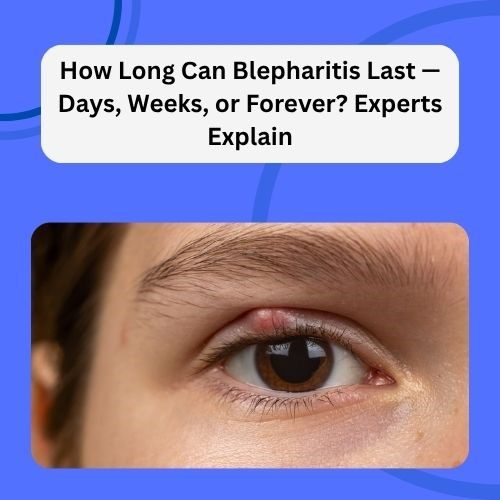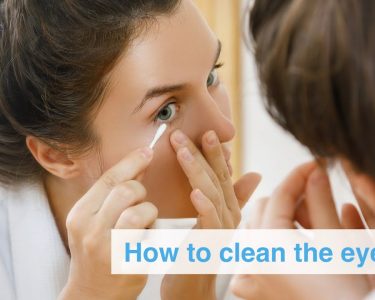Blepharitis is one of those eye conditions that can be stubborn, confusing, and frustrating to manage. Many people wonder: how long can blepharitis last? The answer isn’t simple — it varies from person to person, depending on the cause, severity, and how well you manage your eye hygiene. Some people experience it for just a few days, while others deal with it for weeks or even as a chronic condition that never fully disappears.
In this article, we’ll explore everything you need to know about blepharitis duration, what affects its healing time, and how you can manage it effectively so that symptoms don’t return.
What Is Blepharitis?
Blepharitis is an inflammation of the eyelid margins — the area where your eyelashes grow. It can affect one or both eyes and often causes redness, swelling, itching, and crusting around the eyelashes. This inflammation happens when the tiny oil glands near the base of the lashes become clogged or infected, disrupting the natural tear film and leading to irritation.
There are two main types:
- Anterior blepharitis – affects the outer part of the eyelid, where the eyelashes attach.
- Posterior blepharitis – involves the inner part of the eyelid, linked to dysfunction of the Meibomian glands.
Though it sounds minor, blepharitis can cause ongoing discomfort and affect your quality of life, especially if not properly treated.
How Long Can Blepharitis Last?
The duration of blepharitis depends on its underlying cause and how consistently it’s managed. Generally:
- Mild cases can improve within a few days to a couple of weeks with proper eyelid hygiene and warm compresses.
- Moderate cases may take several weeks or months to resolve.
- Chronic blepharitis may persist for years, with symptoms that come and go.
Experts explain that blepharitis is often a chronic condition, meaning it can last indefinitely — not necessarily because it’s untreatable, but because it tends to flare up repeatedly. It’s similar to skin conditions like eczema or rosacea, where symptoms subside but may reappear due to triggers such as allergies, bacterial growth, or poor eyelid hygiene.
So, if you’re asking “how long can blepharitis last?”, the answer is — it can last anywhere from a few days to a lifetime, depending on care and prevention.
Factors That Influence How Long Blepharitis Lasts
Several factors determine whether your blepharitis clears up quickly or lingers:
Underlying Cause
Blepharitis can be caused by bacteria, skin conditions (like seborrheic dermatitis or rosacea), allergies, or dysfunction in the oil glands. Treating the root cause is essential to shortening its duration.
Consistency of Eyelid Hygiene
One of the biggest mistakes people make is stopping eyelid cleaning once symptoms improve. Maintaining consistent hygiene is key to keeping blepharitis under control. If you’re wondering how to clean eyelids blepharitis, it usually involves using a gentle cleanser, warm water, and cotton pads to remove debris and bacteria daily.
Type of Blepharitis
Posterior blepharitis, linked to Meibomian gland dysfunction, tends to last longer and be more difficult to manage than anterior blepharitis.
Medical Treatment and Compliance
Using prescribed antibiotics, steroid eye drops, or artificial tears as directed by an ophthalmologist can significantly shorten the recovery time.
5. Lifestyle and Diet
Diet plays a role in inflammation. Including omega-3 fatty acids and avoiding processed foods can improve eye health and reduce flare-ups. If you’re focusing on key nutrients and foods to include or avoid, consider fatty fish, flaxseed oil, leafy greens, and foods rich in zinc and vitamin A.
Is Blepharitis Permanent?
Unfortunately, blepharitis can be a lifelong condition for some people. While you can control and reduce symptoms with proper care, it may not completely go away. Chronic cases often cycle through flare-ups and remissions.
However, with consistent eyelid hygiene, lifestyle adjustments, and the right treatment plan, you can manage symptoms effectively and live comfortably.
Think of it like managing a chronic skin condition — regular care keeps the symptoms at bay.
How to Know if Blepharitis Is Getting Better
You can tell your blepharitis is improving when:
- Redness and swelling reduce.
- The crusting and flakes around your lashes start disappearing.
- Your eyes feel less itchy or irritated.
- There’s less burning or tearing.
If your symptoms persist or worsen despite home treatment, consult an eye specialist. You might need prescription medication or further testing to rule out other eye issues like dry eye syndrome or infection.
Can Blepharitis Come Back After Treatment?
Yes, blepharitis can return even after successful treatment. Many people experience recurring flare-ups, especially if they stop their eyelid hygiene routine or are exposed to triggers. Regular maintenance and monitoring are the best ways to prevent recurrence.
Using mild cleansers and avoiding makeup during flare-ups can also help minimize irritation.
Home Remedies and Natural Management
There are several ways to manage blepharitis naturally. While these don’t replace medical advice, they can help soothe symptoms and promote healing.
Warm Compresses
Applying a warm compress to the eyelids helps loosen crusts, melt clogged oils, and improve gland function. Use a clean cloth soaked in warm water and hold it against your eyes for 5–10 minutes twice daily.
Eyelid Scrubs
Gently scrubbing the eyelid margins with diluted baby shampoo or specialized eyelid wipes can remove bacteria and debris. This is the most practical answer for people researching how to clean eyelids blepharitis.
Natural Remedies for Blepharitis
Some natural remedies may support healing, including tea tree oil (diluted for mites), aloe vera gel for soothing irritation, and omega-3 supplements for reducing inflammation. These natural remedies for blepharitis can complement medical treatments but should be used cautiously to avoid eye irritation.
Home Remedies for Eye Infection Blepharitis
Simple solutions like applying warm compresses, keeping makeup brushes clean, and maintaining eyelid hygiene are often effective. These easy home remedies for eye infection blepharitis can help you manage symptoms from home.
Blepharitis and Eyelash Extensions: The Hidden Connection
Many people develop eyelid irritation after getting lash extensions. The glue, adhesive fumes, or improper aftercare can block oil glands and trigger inflammation — this is the reality of blepharitis from eyelash extensions.
If you notice redness, swelling, or crusting after a lash extension procedure, it’s best to remove the extensions and allow your eyelids to recover naturally. Cleaning the area gently and avoiding further cosmetic irritants can prevent worsening symptoms.
Medical and Alternative Treatments
Treatment depends on the type and cause of blepharitis. Doctors typically recommend a combination of hygiene routines and medication.
Conventional Treatments
- Antibiotic ointments or drops: To target bacterial infections.
- Steroid eye drops: To reduce inflammation and swelling.
- Artificial tears: To relieve dryness.
- Oral antibiotics (like doxycycline): For severe or chronic cases.
Blepharitis Alternative Treatments
In addition to medical care, some people explore blepharitis alternative treatments like acupuncture, herbal eye washes, or probiotic supplements. While scientific evidence is limited, these approaches may offer comfort and support the healing process when combined with traditional care.
Diet and Nutrition for Eye Health
Diet plays an essential role in inflammation management. Including anti-inflammatory nutrients and avoiding certain foods can help you control flare-ups.
Here’s a brief look at key nutrients and foods to include or avoid for those managing blepharitis:
- Include: Omega-3 fatty acids (salmon, chia seeds), vitamin A (carrots, spinach), zinc (pumpkin seeds), and vitamin C-rich foods (berries, citrus).
- Avoid: Processed foods, sugary snacks, alcohol, and trans fats, as they can trigger inflammation.
Staying hydrated and eating a balanced diet can improve your tear film quality and overall eye comfort.
Supplements That May Support Eye Health
Some people find relief using specific supplements designed to improve eyelid and gland function. For example, Tarcical – blepharitis eye health supplement for pain is marketed as a supportive product that may reduce discomfort and inflammation. While it shouldn’t replace medical advice or treatment, supplements like these can complement an overall eye care plan.
Always consult your doctor before taking any new supplement to ensure it’s safe and appropriate for your condition.
Preventing Future Flare-Ups
While blepharitis can be persistent, you can significantly reduce flare-ups with good eye hygiene and healthy habits.
Daily Eyelid Cleaning
Even after symptoms fade, continue cleaning your eyelids every day. This helps prevent bacteria and debris buildup.
Avoid Eye Makeup During Flare-Ups
Makeup can worsen irritation. Avoid mascara, eyeliner, and eyeshadow until your eyelids heal.
Replace Old Makeup and Brushes
Bacteria thrive in old makeup. Replace products regularly and clean brushes often.
Manage Skin Conditions
If you have rosacea, dandruff, or eczema, managing these can help control blepharitis flare-ups too.
Regular Eye Exams
Visit your optometrist or ophthalmologist regularly to monitor your eye health, especially if symptoms recur.
When to See a Doctor
You should consult an eye specialist if:
- Symptoms persist for more than a few weeks.
- Your vision becomes blurry.
- Pain, redness, or swelling increases.
- You develop sensitivity to light.
Your doctor can identify whether your condition is bacterial, allergic, or related to gland dysfunction and tailor treatment accordingly.
Final Thoughts
So, how long can blepharitis last? The duration varies widely — from a few days to potentially a lifetime of managing flare-ups. What matters most is consistency in care. Daily cleaning, a healthy diet, and regular medical checkups can help control symptoms and prevent recurrence.
Whether you choose medical treatments, natural remedies for blepharitis, or a mix of both, remember that patience and persistence are key. By caring for your eyes daily and understanding your triggers, you can keep blepharitis under control and protect your vision for years to come.




